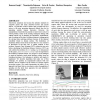Free Online Productivity Tools
i2Speak
i2Symbol
i2OCR
iTex2Img
iWeb2Print
iWeb2Shot
i2Type
iPdf2Split
iPdf2Merge
i2Bopomofo
i2Arabic
i2Style
i2Image
i2PDF
iLatex2Rtf
Sci2ools
VLDB
2004
ACM
2004
ACM
Indexing Large Human-Motion Databases
Data-driven animation has become the industry standard for computer games and many animated movies and special effects. In particular, motion capture data recorded from live actors, is the most promising approach offered thus far for animating realistic human characters. However, the manipulation of such data for general use and re-use is not yet a solved problem. Many of the existing techniques dealing with editing motion rely on indexing for annotation, segmentation, and re-ordering of the data. Euclidean distance is inappropriate for solving these indexing problems because of the inherent variability found in human motion. The limitations of Euclidean distance stems from the fact that it is very sensitive to distortions in the time axis. A partial solution to this problem, Dynamic Time Warping (DTW), aligns the time axis before calculating the Euclidean distance. However, DTW can only address the problem of local scaling. As we demonstrate in this paper, global or uniform scaling i...
| Added | 02 Jul 2010 |
| Updated | 02 Jul 2010 |
| Type | Conference |
| Year | 2004 |
| Where | VLDB |
| Authors | Eamonn J. Keogh, Themis Palpanas, Victor B. Zordan, Dimitrios Gunopulos, Marc Cardle |
Comments (0)

